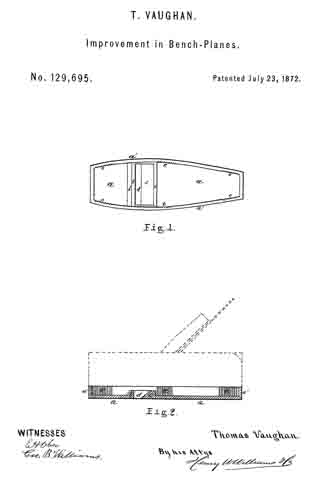No. 129,695 – Improvement In Bench-Planes (Thomas Vaughan) (1872)

UNITED STATES PATENT OFFICE.
_________________
THOMAS VAUGHAN, OF BOSTON, MASSACHUSETTS.
IMPROVEMENT IN BENCH-PLANES.
_________________
Specification forming part of Letters Patent No. 129,695, dated July 23, 1872.
_________________
Specification describing certain Improvements in Bench-Planes, invented by THOMAS VAUGHAN, of Boston, in the county of Suffolk and State of Massachusetts.
My invention relates to a metallic shoe, into which the wooden body of the plane is fitted and secured by means of cement, said shoe being strengthened by ribs before and behind the cutter, and having grooves or flutings cut in various places upon its inner sides to hold the cement.
In the accompanying drawing, Figure 1 is a plan of the shoe, showing its shape, &c. Fig. 2 is a longitudinal section of the same, the shape and position of the plane being shown by dotted lines.
Similar letters of reference indicate corresponding parts.
a is the bottom of the shoe. a’ a’ are the sides and ends. In is the rib in front of the cutter. c is the rib behind the cutter. d is the opening for the cutter. e e e are flutings or grooves in the sides a’ a’.
This shoe is made of malleable cast-iron, and the body of the plane is cut away so as to fit into the shoe. The plane is secured therein by means of prepared cement, the flutings e e being for the purpose of more thoroughly fastening it, the cement filling into them. The ribs b c are intended to strengthen the shoe, and are very important, as it would without them be very liable to break when meeting with a fall from a considerable height. The casting throughout is of uniform thickness, (probably one~eighth of an inch ,) which gives the plane good proportionate weight. In planes made with my shoe I shall construct the cutter of gaged or uniform thickness throughout, so that the opening d shall retain its size and appearance as the cutter wears off. The cutter will also be secured by a wedge in the ordinary way. My plane (having the shoe) will “clean up” the hardest veneer without requiring a scraper, a few rubs with sand-paper being sufficient for any wood requiring the best French polish even.
A plane made as above-described, and having my shoe, costs about one-half as much as planes now in the market and purporting to do similar work. The wear is, of course, unlimited. The general shape of my shoe may be altered, of course, to fit different planes, such as block-planes; but the other features of the invention will be substantially unaltered.
I do not claim as my invention an iron or entirely metallic plane, but my shoe, in which is set a wooden plane, constructed as above described.
Having thus fully described , my invention, what I claim, and desire to secure by Letters Patent, is —
The combination and arrangement of tl shoe and sides and ends thereof a a’, ribs b c, and flutings e e, substantially as above described, and for the purposes hereinbefore set forth.
THOMAS VAUGHAN.
Witnesses:
HENRY W. WILLIAMS,
E. H. OBER.


